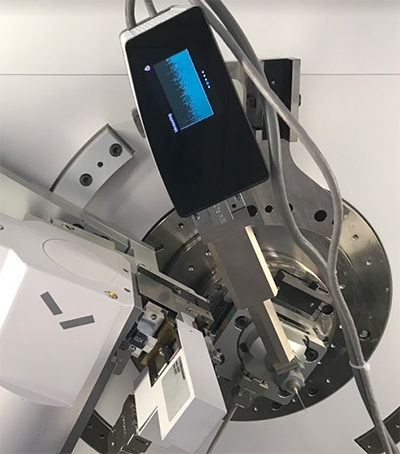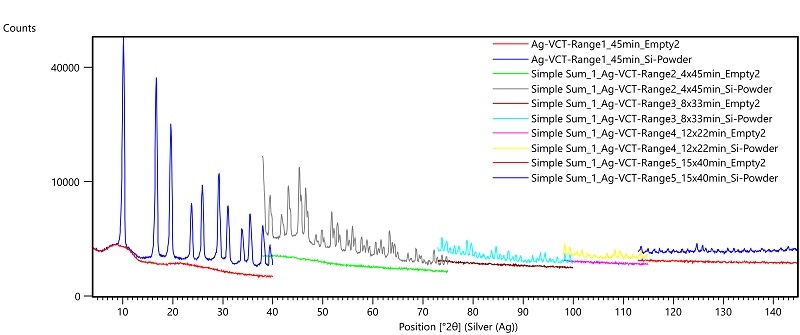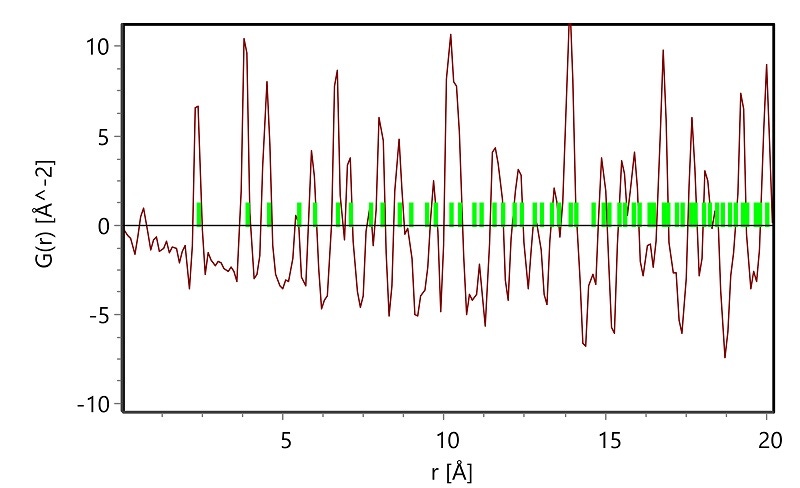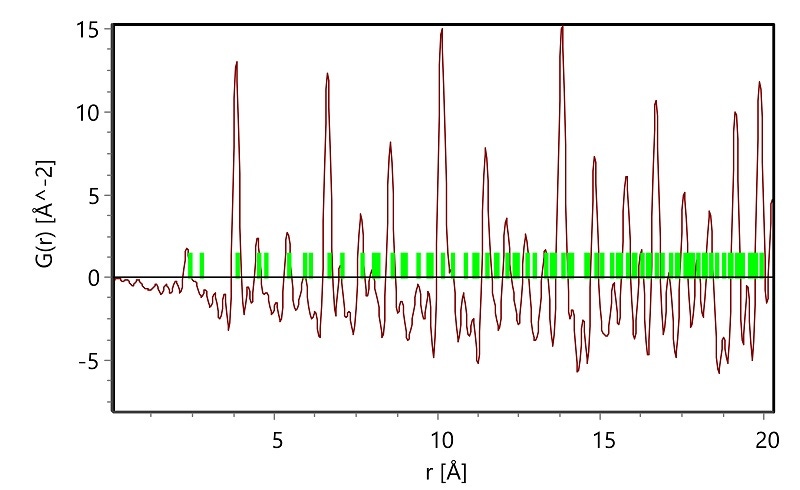Here we show how the 1Der detector on the Empyrean platform offers real choice, versatility and excellence in Total Scattering measurements for Pair Distribution Function (PDF) analysis. The 1Der detector brings a whole new capability to an Empyrean system which can be configured to provide an all-in-one measurement solution, enabling seamless transition between classic powder X-ray diffraction (XRD) and novel PDF measurements.
By including measurement of disorder in a material, PDF analysis is becoming increasingly widespread and is used as a companion to classic phase analysis with crystal structure refinement, to give a complete view of a material [1]. No material is perfectly crystalline, and scientists are becoming ever more interested in the role that imperfections and amorphous regions play in defining the functional properties of complex crystals [2]. Here we show that, with full digital control of detector length and energy acceptance window, the 1Der can switch seamlessly between configurations and hence facilitate multiple applications on one system.
We demonstrate two experimental set-ups for total scattering measurements on the Empyrean system and show high-quality PDF data using HighScore analysis software. The results on test samples show excellent agreement with known atomic spacings. Together these results illustrate the versatility and performance of the 1Der detector in total scattering experiments.
The examples shown here employ an incident beam slit system, which can be considered as an entry level optic. There are also multiple incident beam options for the Empyrean including focussing mirrors and Bragg BrentanoHD optics, ask your local representative for more information!
Here we show how the 1Der detector on the Empyrean platform offers real choice, versatility and excellence in Total Scattering measurements for Pair Distribution Function (PDF) analysis. The 1Der detector brings a whole new capability to an Empyrean system which can be configured to provide an all-in-one measurement solution, enabling seamless transition between classic powder X-ray diffraction (XRD) and novel PDF measurements.
By including measurement of disorder in a material, PDF analysis is becoming increasingly widespread and is used as a companion to classic phase analysis with crystal structure refinement, to give a complete view of a material [1]. No material is perfectly crystalline, and scientists are becoming ever more interested in the role that imperfections and amorphous regions play in defining the functional properties of complex crystals [2]. Here we show that, with full digital control of detector length and energy acceptance window, the 1Der can switch seamlessly between configurations and hence facilitate multiple applications on one system.
We demonstrate two experimental set-ups for total scattering measurements on the Empyrean system and show high-quality PDF data using HighScore analysis software. The results on test samples show excellent agreement with known atomic spacings. Together these results illustrate the versatility and performance of the 1Der detector in total scattering experiments.
The examples shown here employ an incident beam slit system, which can be considered as an entry level optic. There are also multiple incident beam options for the Empyrean including focussing mirrors and Bragg BrentanoHD optics, ask your local representative for more information!

Figure 1. Empyrean configuration for transmission incorporating Ag X-ray tube, Rh filter, programmable divergence slits, capillary spinner sample stage and the 1Der detector.
The transmission configuration as shown in Figure 1, with a sample in a capillary is the most flexible set-up for a total scattering measurement. Transmission is also the cleanest way to achieve a PDF analysis because if the ease with which an empty capillary measurement can be used to subtract background from the data. Figure 2 shows data collected for a test sample of powdered silicon in a glass capillary. The data at lower values of Position [o2θ], contains information about the highly ordered (crystalline) part of the sample and at higher angles provides measurements of the frequency of inter-atomic distances in disordered regions of the material.

Figure 2. High quality total scattering scans collected for PDF analysis using a transmission measurement
HighScore software offers a choice of data treatment options including subtraction of background obtained from measurement of blank capillaries. HighScore also incorporates a robust algorithm [3] for treatment of total scattering scans and conversion of these into an atomic pair distribution G(r) vs radial distance, as shown in Figure 3. This graph shows the relative frequency of atomic pair radial distances in the sample. The measured peaks compare well with those expected for the test sample as indicated by the green markers.

Figure 3. Atomic pair distribution function for a Si powder sample showing the first 53 atom distances (see green markers) in the range from 0 to 20Å.
Highly absorbing materials may not be suitable for transmission geometry or not everyone has access to a capillary spinner. Figure 4 shows the reflection geometry set-up with a Ceria powder test sample in a conventional powder spinner stage. This geometry also offers the advantage of automation via the sample changer. In reflection geometry the energy discrimination of the 1Der detector provides an unprecedented spectral purity for Ag radiation, which is otherwise impossible to obtain with a slit system. HighScore software can provide specific background corrections for this geometry. In figure 5 the measured pair distribution function shows that the performance is uncompromised as the PDF data (red line) agree well with the expected atomic-pair distances (green markers) for the sample.

Figure 4. Empyrean configuration for reflection incorporating Ag X-ray tube, Rh filter, programmable divergence slits, R-T spinner sample stage, and the 1Der detector.

Figure 5. Atomic pair distribution function for a Ceria (CeO2) powder sample showing the first 126 atom distances (see green markers) in the range from 0 to 20Å.
With the 1Der detector you have more choice. For a truly multipurpose Empyrean with a PDF capability the 1Der gets you data that you can rely on.
The compactness and narrow energy window of 1Der means that you can also collect excellent high-angle data in reflection geometry. It is rare to achieve such spectral purity for a scan using Ag radiation and without monochromation. 1Der has opened the possibilities further on an already competent platform. With 1Der on Empyrean you can unlock a new sense of wonder and discover more about your materials.
[1] On the use of laboratory X-ray diffraction equipmentfor Pair Distribution Function (PDF) studies. C. A. Reiss, A. Kharchenko and M. Gateshki. Z. Kristallogr. 2012, 227, 257–261 / DOI 10.1524/zkri.2012.1492
[2] Applications of pair distribution function methods to contemporary problems in materials chemistry. C. A. Young and A. L. Goodwin. J. Mater. Chem., 2011,21, 6464-6476
[3] Extracting the pair distribution function from white-beam X-ray total scattering data. A.K. Soper and E.R. Barney, J. Appl. Cryst. (2011), 44, 714 - 726.